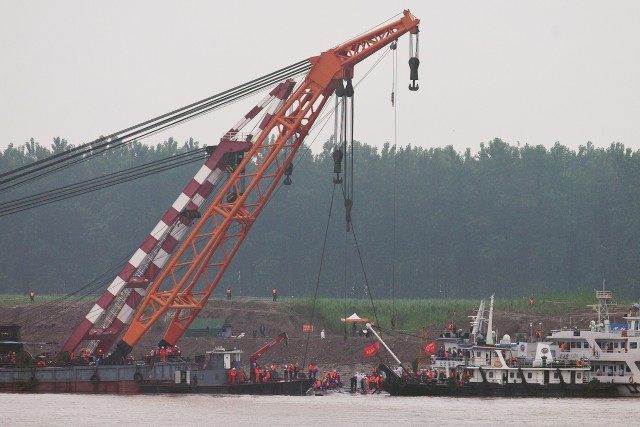JIANLI, China (AP) — Rescuers cut three holes into the overturned hull of a river cruise ship in unsuccessful attempts to find more survivors Thursday, as the death toll in the Yangtze River disaster reached 75. More than 360 people remain missing and are feared dead.
Workers stabilized the ship with cranes and then cut into sections of the hull, which jutted above the river’s gray currents, to check for survivors before welding the sections back to the hull to preserve the ship’s buoyancy and balance, Chinese state broadcaster CCTV said.
So far, authorities say at least 14 people survived Monday night’s sudden capsizing in a severe storm, some by jumping from the ship during the early moments and swimming or drifting ashore. Three of them were pulled by divers from air pockets inside the overturned hull Tuesday after rescuers heard yells for help coming from inside.
Although chances of finding anyone else alive have all but disappeared, Chinese officials have not yet declared the search over.
More than 200 divers were working underwater in three shifts to search the ship’s cabins one by one, the broadcaster said. Rescuers pulled out 49 bodies Thursday, bringing the toll to 75, Jianli county chief Huang Zhen told reporters. They were brought to the Jianli’s Rongcheng Crematorium, in Hubei province, where at least two relatives tried to identify them.
Among the crowd observing developments outside the crematorium was farmer Wang Xun, who noted that many of the boats passengers were elderly.
“I can’t imagine how terrifying it must have been for them,” Wang said. “Old people should be with their families and go peacefully, not like this.”
The Eastern Star capsizing will likely become the country’s deadliest boat disaster in seven decades, and Chinese authorities have launched a high-profile response that has included sending Premier Li Keqiang to the accident site, while tightly controlling media coverage.
The Communist Party’s Poliburo Standing Committee, the country’s highest power, convened a meeting and issued a directive for officials to step up efforts to control public opinion about the disaster response, while ordering them to both “understand the sorrow of the families” and “concretely preserve social stability.”
Many of the more than 450 people on board the multi-decked, 251-foot (77-meter) -long Eastern Star were reported to be retirees taking in the scenic vistas of the Yangtze on a cruise from Nanjing to the southwestern city of Chongqing.
The survivors included the ship’s captain and chief engineer, both of whom have been taken into police custody. Some relatives have questioned whether the captain should have brought the ship ashore at the first signs of a storm, and whether everything possible was done to ensure the safety of the passengers after the accident. They have demanded help from officials in Nanjing and Shanghai to travel to the site in unruly scenes that have drawn a heavy police response.
Records from a maritime agency show the capsized ship was cited for safety violations two years ago. Authorities in Nanjing held the ship and five other Yangtze cruise vessels after it found them violating standards during a safety inspection campaign in 2013, according to a report on the city’s Maritime Safety website. It didn’t specify the Eastern Star’s violations.
The shallow-draft boat, which was not designed to withstand as heavy winds as an ocean-going vessel can, overturned in what Chinese weather authorities have called a cyclone with winds up to 130 kilometers (80 miles) per hour. The sudden capsizing meant many passengers were unable to grab life jackets, Zhong Shoudao, president of the Chongqing Boat Design Institute, said at a news conference Wednesday.
Access to the accident site was blocked by police and paramilitary troops stationed along the Yangtze embankment.
China’s deadliest maritime disaster in recent decades was when the Dashun ferry caught fire and capsized off Shandong province in November 1999, killing about 280.
With 75 dead and more than 360 people still missing, the Eastern Star disaster could become China’s deadliest boat accident since the sinking of the SS Kiangya off Shanghai in 1948, which is believed to have killed anywhere from 2,750 to nearly 4,000 people.
___
Associated Press writer Jack Chang and Ian Mader and news assistant Yu Bing in Beijing, video journalist Helene Franchineau in Jianli, China, and Elaine Kurtenbach in Tokyo contributed to this report.

COMMENTS
Please let us know if you're having issues with commenting.